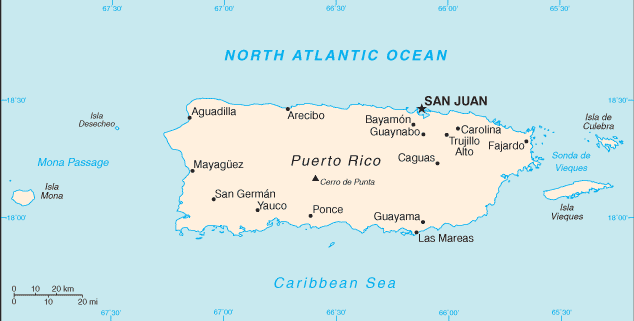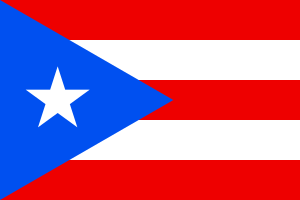Puerto Rico

Stuck right between regions - sometimes it's the smallest of the Greater Antilles, sometimes the largest of the Lesser - Puerto Rico, a mere 110 miles by 40 miles if measuring loosely, is one of two current United States commonwealths/semi-autonomous territories. This has some indefinite difference with simple territories (such as Guam), but legally works out to the same as the United States Constitution does not recognize a "commonwealth" as a true status.
The island's first inhabitants were the Tainos, tribesmen similar to those of South America, but less aggressive. When the Spanish found the island (in Colombus' second trip to the New World) the Tainos believed them to be gods (similar to what happened with Cortez in Mexico) and submitted to them, until they got suspicious and decided to try drowning one of them to see if he was immortal. Of course, he proved not to be, leading to an uprising against the invaders, but they were no match for them and ended up enslaved and eventually absorbed into the local gene pool (a similar fate was suffered by the African slaves.) Puerto Ricans today are proud of their multicultural origins, as can be seen in everything from its towns (some still bearing Taino names) to the African rhythms of the local music.
Settled in 1508 by Juan Ponce de Leon, its first governor, Puerto Rico was ruled for most of its history by Spain, with the exact quality of said rule depending on the King (or later Queen) in power. The 19th century was an especially troubled time, with several succeeding monarchs and their Prime Ministers allowing reforms, only to later rescind them and later reinstate them. One high point came when Ramon Power, a Puerto Rican officer in the Spanish Navy descended from Irish immigrants, served as vice-president of the Spanish Cortes (equivalent to Parliament) during the Napoleonic Wars.
Most of the late 19th century history of Puerto Rico can be characterized by the development of political organizations seeking autonomous rule for the island. This was finally achieved in 1898, when the first autonomous government of Puerto Rico took power approximately one month before the United States invasion. It is worth noting that said government was similar, at least in broad strokes, to the Dominion of Canada: the only Spanish military officer on the island was its Governor-General, and served exclusively as the representative of the Crown; Puerto Rico agreed to answer to the Spanish crown on matters of defense and foreign affairs, but retained complete power over internal ones; and for the first time, could raise its own defense forces, land and sea alike, though it would depend on the Spanish Armed Forces in wartime.
Since 1898, Puerto Rico's relationship with the U.S. has been alternately good (sugar boom in the 1920s, ratification of the Puerto Rican Constitution and Operation Bootstrap in the 1950s, modern-day pharmaceutical and manufacturing boom) and bad (Governors Guy V. Henry, E. Montgomery Reilly, Blanton Winship). A recent report on the island reveals that the United States does not and will not consider the current status as "commonwealth" a viable option for the island's permanent future. The generally-accepted options for Puerto Rico's future (besides the status quo) are independence (which has a small but significant following) and statehood (which has a fairly large following but not a majority). The US Army has designed a 51-star flag just in case the latter happens.
Puerto Rico is home to many beautiful beaches, 56 animal and 239 plant indigenous species, one of which is the emblematic coqui frog. Puerto Ricans have distinguished themselves in many fields, including music (Tito Puente, Celia Cruz, Jose Feliciano, Hector Lavoe), literature (Rosario Ferre, Tato Laviera, Miguel Algarin), the military (RADM Frederick Lois Riefkohl, USN; ADM Horacio Rivera, USN), and beauty pageants, with five victories in Miss Universe (Puerto Rico often sends representatives to international events separate from the American ones), second most successful in that pageant, and not surprisingly as Puerto Rican women have been described as staggeringly beautiful since Columbus' voyage there in 1493. However, poverty remains an ongoing challenge in many areas.
Puerto Rico uses the US dollar, most of its GDP comes from either tourism or the pharmaceutical sector (it seems to oscillate every few years), and home to some of the nicest people in the world, especially in the rural areas. Roman Catholicism is the single largest denomination with the most adherents, as is the case with most Latin American countries, though Protestants and other non-Catholic denominations make up a substantial minority. There are also small Jewish, Muslim, Hindu, and Buddhist communities. Spanish and English are both official languages at the moment, with each generation generally learning to speak English better than the last. Nonetheless, a working knowledge of Spanish, and recognition of the fact that saying things loudly and slowly doesn't help if you can't understand what is being said, will go a long way towards making your stay enjoyable.
The Puerto Rican Flag
